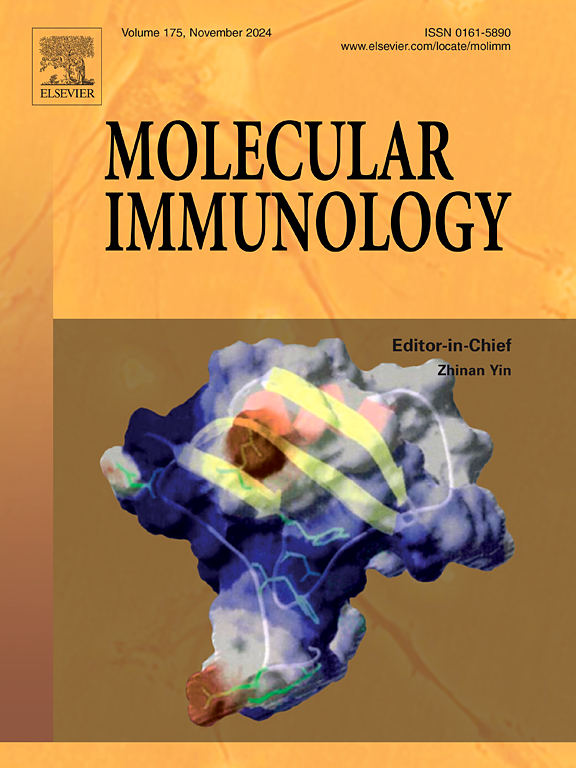中性粒细胞来源的外泌体S100A8通过诱导焦亡加重败血症的肺损伤
IF 3.2
3区 医学
Q2 BIOCHEMISTRY & MOLECULAR BIOLOGY
引用次数: 0
摘要
急性肺损伤(ALI)是脓毒症患者常见且危及生命的并发症,促炎细胞焦亡在相关器官损伤中起着至关重要的作用。在这项研究中,我们旨在确定潜在的治疗靶点。利用GEO数据库(GSE232753),我们分析了健康个体和脓毒症患者外周血中的差异表达基因,确定了显著上调的基因S100A8。随后,我们使用脂多糖(LPS)构建了脓毒性ALI模型。值得注意的是,S100A8不仅在血清和支气管肺泡灌洗液(BALF)中高表达,而且在中性粒细胞外泌体中也高表达。然后,我们将BEAS-2B细胞与中性粒细胞外泌体共孵育,中性粒细胞外泌体分别用LPS处理或未处理。CCK-8法检测细胞增殖活性,PI染色法检测细胞死亡,Western blot和ELISA法检测细胞焦亡指标变化。为了进一步验证lps诱导的中性粒细胞外泌体通过传递S100A8促进BEAS-2B细胞的凋亡,我们进行了额外的实验,包括单独添加S100A8蛋白或S100A8抗体结合中性粒细胞外泌体处理,然后进行相关评估。此外,还进行了体内验证。在机制上,我们发现S100A8通过TLR4信号通路诱导BEAS-2B细胞焦亡。总之,我们的发现为脓毒性ALI的治疗提供了新的有希望的靶点。本文章由计算机程序翻译,如有差异,请以英文原文为准。
Neutrophil-derived exosomal S100A8 aggravates lung injury in sepsis by inducing pyroptosis
Acute lung injury (ALI) is a common and life-threatening complication in patients with sepsis, with pro-inflammatory cell pyroptosis playing a crucial role in the associated organ damage. In this study, we aimed to identify potential therapeutic targets. Utilizing the GEO database (GSE232753), we analyzed the differentially expressed genes in the peripheral blood of healthy individuals and sepsis patients, identifying the significantly upregulated gene S100A8. Subsequently, we constructed a septic ALI model using lipopolysaccharide (LPS). Notably, S100A8 was highly expressed not only in serum and bronchoalveolar lavage fluid (BALF) but also in neutrophil exosomes. We then co-incubated BEAS-2B cells with neutrophil exosomes that were either treated or untreated with LPS. Cell proliferation activity was assessed using the CCK-8 assay, cell death was evaluated through propidium iodide (PI) staining, and the changes in pyroptosis indicators were detected via Western blot and ELISA. To further validate that LPS-induced neutrophil exosomes promote BEAS-2B cell pyroptosis through the delivery of S100A8, we conducted additional experiments involving the addition of S100A8 protein alone or S100A8 antibody in conjunction with neutrophil exosome treatment, followed by relevant assessments. Moreover, in vivo validation was also performed. Mechanistically, we revealed that S100A8 induces pyroptosis in BEAS-2B cells through the TLR4 signaling pathway. In conclusion, our findings provide new promising targets for the treatment of septic ALI.
求助全文
通过发布文献求助,成功后即可免费获取论文全文。
去求助
来源期刊

Molecular immunology
医学-免疫学
CiteScore
6.90
自引率
2.80%
发文量
324
审稿时长
50 days
期刊介绍:
Molecular Immunology publishes original articles, reviews and commentaries on all areas of immunology, with a particular focus on description of cellular, biochemical or genetic mechanisms underlying immunological phenomena. Studies on all model organisms, from invertebrates to humans, are suitable. Examples include, but are not restricted to:
Infection, autoimmunity, transplantation, immunodeficiencies, inflammation and tumor immunology
Mechanisms of induction, regulation and termination of innate and adaptive immunity
Intercellular communication, cooperation and regulation
Intracellular mechanisms of immunity (endocytosis, protein trafficking, pathogen recognition, antigen presentation, etc)
Mechanisms of action of the cells and molecules of the immune system
Structural analysis
Development of the immune system
Comparative immunology and evolution of the immune system
"Omics" studies and bioinformatics
Vaccines, biotechnology and therapeutic manipulation of the immune system (therapeutic antibodies, cytokines, cellular therapies, etc)
Technical developments.
 求助内容:
求助内容: 应助结果提醒方式:
应助结果提醒方式:


